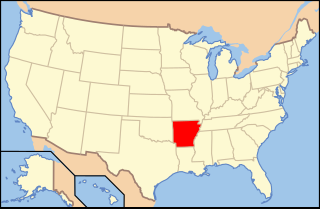
Ashley County is a rural South Arkansas county with a culture, economy, and history based on timber and agriculture. Created as Arkansas's 52nd county on November 30, 1848, Ashley County has seven incorporated municipalities, including Hamburg, the county seat and Crossett, the most populous city. The county is also the site of numerous unincorporated communities and ghost towns. The county is named for Chester Ashley, a prominent lawyer in the Arkansas Territory and U.S. senator from the state from 1844 to 1848.

Arkadelphia is a city in Clark County, Arkansas, United States. As of the 2010 census, the population was 10,714. The city is the county seat of Clark County. It is situated at the foothills of the Ouachita Mountains. Two universities, Henderson State University and Ouachita Baptist University, are located here. Arkadelphia was incorporated in 1857.

Nashville is a city in Howard County, Arkansas, United States. The population was 4,627 at the 2010 census. The estimated population in 2018 was 4,425. The city is the county seat of Howard County.

North Little Rock is a city in Pulaski County, Arkansas, United States, across the Arkansas River from Little Rock in the central part of the state. The population was 64,591 at the 2020 census. In 2019 the estimated population was 65,903, making it the seventh-most populous city in the state. North Little Rock, along with Little Rock and Conway, anchors the six-county Little Rock–North Little Rock–Conway Metropolitan Statistical Area, which is further included in the Little Rock-North Little Rock Combined Statistical Area with 902,443 residents.

Mount Holly Cemetery is a historic cemetery located in the Quapaw Quarter area of downtown Little Rock in the U.S. state of Arkansas, and is the burial place for numerous Arkansans of note. It was listed on the National Register of Historic Places in 1970 and has been nicknamed "The Westminster Abbey of Arkansas".

Daisy Bates was an American civil rights activist, publisher, journalist, and lecturer who played a leading role in the Little Rock Integration Crisis of 1957.
The Quapaw Quarter of Little Rock, Arkansas, is a section of the city including its oldest and most historic business and residential neighborhoods. The area's name was first given in 1961, honoring the Quapaw Indians who lived in the area centuries ago.
Hubert Eugene "Geese" Ausbie is a retired professional basketball player.

Arkansas Baptist College (ABC) is a private Baptist-affiliated historically black college in Little Rock, Arkansas. Founded in 1884 as the Minister's Institute, ABC was initially funded by the Colored Baptists of the State of Arkansas. It is the only historically black Baptist school west of the Mississippi River. The Main Building on its campus, built in 1893, is one of the oldest surviving academic buildings in the state, and was listed on the National Register of Historic Places in 1976.

The former First Church of Christ, Scientist, now the Little Rock Community Church, is a historic church building at 2000 South Louisiana Street in Little Rock, Arkansas. It is a single-story Mission style building, designed by noted Arkansas architect John Parks Almand and completed in 1919. Characteristics of the Mission style include the low-pitch tile hip roof, overhanging eaves with exposed rafter ends, and smooth plaster walls. The building also has modest Classical features, found in pilaster capitals and medallions of plaster and terra cotta. The building is local significant for its architecture. It was built for the local Christian Science congregation, which in 1950 sold it to an Evangelical Methodist congregation. That congregation has since severed its association with the Evangelical Methodist movement, and is now known as the Little Rock Community Church.

Little Rock is the capital and most populous city of the U.S. state of Arkansas. The city's population was 202,591 in 2020 according to the United States Census Bureau. As the county seat of Pulaski County, the city was incorporated on November 7, 1831, on the south bank of the Arkansas River close to the state's geographic center. The city derived its name from a rock formation along the river, named the "Little Rock" by the French explorer Jean-Baptiste Bénard de la Harpe in 1722. The capital of the Arkansas Territory was moved to Little Rock from Arkansas Post in 1821. The six-county Little Rock–North Little Rock–Conway, AR Metropolitan Statistical Area (MSA) is ranked 78th in terms of population in the United States with 738,344 residents according to the 2017 estimate by the United States Census Bureau.

The Robinson Center is a performance, convention, and exhibition space at Statehouse Plaza in downtown Little Rock, Arkansas.

The Arkansas Tuberculosis Sanatorium Historic District is a United States Historic District south of Booneville, Arkansas that was listed on the National Register of Historic Places in October 2006. The district encompasses the former relocation center for Arkansans diagnosed with tuberculosis and an administration building built in the Art Deco style in 1909. It is one of the largest and best-preserved surviving complexes of its type in the country.

Jenny Eakin Delony, also known as Jenny Eakin Delony Rice and Jenny Meyrowitz, (1866–1949) was an American painter and educator. She specialized in portraits of notable and historic figures in the United States, but also made miniature, landscape, wildlife, still life, and genre paintings. She was the founder of collegiate art education in Arkansas.

The culture of Arkansas is a subculture of the Southern United States that has come from blending heavy amounts of various European settlers culture with the culture of African slaves and Native Americans. Southern culture remains prominent in the rural Arkansas delta and south Arkansas. The Ozark Mountains and the Ouachita Mountains retain their historical mount. Arkansans share a history with the other southern states that includes the institution of slavery, the American Civil War, Reconstruction, Jim Crow laws and segregation, the Great Depression, and the Civil Rights Movement.

St. Elizabeth's Catholic Church is a historic church at the northeast corner of Sycamore and Mason Streets in DeValls Bluff, Arkansas in the United States. It was built in 1912 and added to the National Register of Historic Places in 2009.

Mount Zion Baptist Church is a historic church at 900 Cross Street in Little Rock, Arkansas. It is a buff brick structure with modest Prairie School features on its exterior, with a three-part facade articulated by brick pilasters, and a trio of entrances set in the center section above a raised basement. The interior of the church is extremely elaborate in its decoration, with a pressed-metal ceiling, elaborate central copper light fixture, and banks of stained glass windows. The church was built in 1926 for a predominantly African-American congregation founded in 1877.

St. Peter's Rock Baptist Church is a historic former church building at 1401 West 18th Street in Little Rock, Arkansas. It is a two-story vernacular brick structure, its main facade featuring a slightly recessed central section with a gable topped by a cross above. The church was built in 1941 for an African-American congregation established in the 1890s. This was the congregation's first purpose-built home, which it occupied until moving to larger quarters on Brown Street in 1975. It has been owned since then by the Greater Little Rock Singing Quartet Center, and continues to serve as a community meeting and performance space.

The Division of Arkansas Heritage (DAH) is a division of the Arkansas Department of Parks, Heritage, and Tourism of the U.S. State of Arkansas responsible for preserving, promoting, and protecting Arkansas's natural and cultural history and heritage. It was known as the Department of Arkansas Heritage until it was merged with the Arkansas Department of Parks and Tourism (ADPT) on July 1, 2019, becoming a division of ADPT's successor, the Arkansas Department of Parks, Heritage, and Tourism.



















